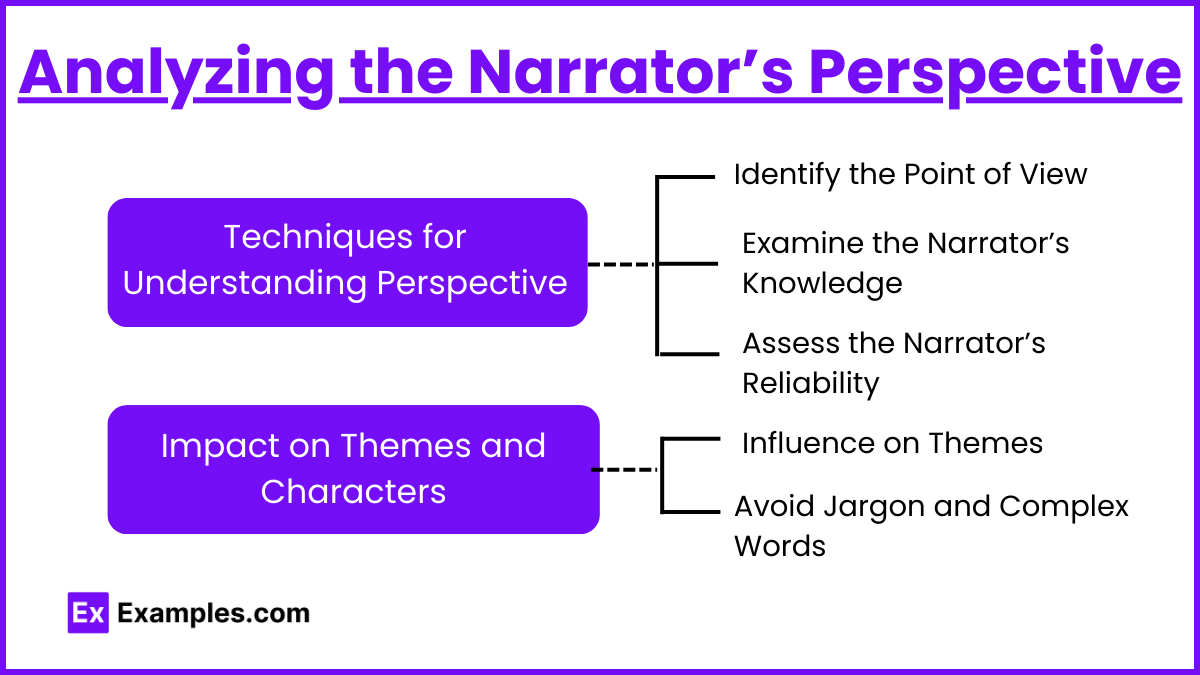In the AP English Language and Composition exam, understanding and interpreting a narrator’s perspective is crucial for crafting insightful and persuasive analyses. Whether engaged in argumentative writing or delivering an argumentative speech, recognizing the narrator’s point of view, biases, and reliability allows you to use rhetorical sentences and cumulative sentences effectively. The narrator’s perspective shapes the reader’s perception of events, characters, and themes, influencing the overall interpretation of the narrative. By mastering this skill, you can enhance your critical analysis, making your arguments more compelling and nuanced, and providing deeper insights into the literature you study.
Learning Objectives
By studying the topic of understanding and interpreting a narrator’s perspective, students will achieve several key learning objectives. They will enhance their critical thinking skills by analyzing how the narrator’s point of view, biases, and reliability affect the narrative. Students will learn to use cumulative sentences and rhetorical sentences to develop thorough analyses in explanatory essays and expository essays. They will also develop the ability to craft a strong final thesis statement that effectively incorporates their interpretations of the narrator’s perspective. Mastery of these techniques will enable students to produce well-structured, engaging, and persuasive literary analyses.
Types of Narrator’s Perspectives

1. First-Person Perspective
- Definition: The narrator is a character in the story, using “I” or “we.”
- Characteristics:
- Provides an intimate and personal view of events.
- Limited to the narrator’s knowledge and experiences.
- Impact on Interpretation:
- Creates a sense of immediacy and connection.
- May introduce bias, as the narrator’s perceptions are subjective.
- Example: “The Catcher in the Rye” by J.D. Salinger.
2. Second-Person Perspective
- Definition: The narrator addresses the reader directly using “you.”
- Characteristics:
- Puts the reader in the position of a character.
- Creates an immersive and engaging experience.
- Impact on Interpretation:
- Can make the reader feel personally involved in the story.
- Often used in experimental or interactive narratives.
- Example: “Bright Lights, Big City” by Jay McInerney.
3. Third-Person Limited Perspective
- Definition: The narrator knows the thoughts and feelings of one character.
- Characteristics:
- Provides a focused view of the story through one character’s perspective.
- Limited to what the focal character knows and experiences.
- Impact on Interpretation:
- Allows for deeper insight into a single character.
- Maintains some narrative distance and objectivity.
- Example: “Harry Potter” series by J.K. Rowling.
4. Third-Person Omniscient Perspective
- Definition: The narrator knows the thoughts and feelings of all characters.
- Characteristics:
- Provides a comprehensive and all-knowing view of the story.
- Can move freely between characters and events.
- Impact on Interpretation:
- Offers a broad and balanced understanding of the narrative.
- Can reveal multiple perspectives and inner thoughts.
- Example: “Pride and Prejudice” by Jane Austen.
Analyzing the Narrator’s Perspective

Techniques for Understanding Perspective
- Identify the Point of View: Determine whether the narration is first-person, second-person, or third-person (limited or omniscient).
- Example: “I walked to the store” (first-person), “You walk to the store” (second-person), “She walked to the store” (third-person).
- Examine the Narrator’s Knowledge: Consider what the narrator knows and does not know.
- Example: A first-person narrator might be unaware of other characters’ motives.
- Assess the Narrator’s Reliability: Evaluate whether the narrator is trustworthy or biased.
- Example: An unreliable narrator might provide misleading or skewed information.
Impact on Themes and Characters
- Influence on Themes: The narrator’s perspective can highlight or obscure certain themes.
- Example: A biased narrator might emphasize themes of prejudice and subjectivity.
- Character Perception: The narrator’s viewpoint shapes how characters are portrayed and understood.
- Example: A limited perspective might present a character as mysterious or misunderstood.
Techniques for Effective Analysis

Close Reading
- Definition: Carefully examine the text to understand the narrator’s perspective.
- Technique: Highlight passages that reveal the narrator’s thoughts, feelings, and knowledge.
Annotation
- Definition: Make notes on the text to track the narrator’s perspective and its impact.
- Technique: Write comments in the margins about the significance of the narrator’s viewpoint.
Comparative Analysis
- Definition: Compare different narrators’ perspectives across multiple texts.
- Technique: Identify similarities and differences in how narrators shape the story and influence interpretation.
Examples
Example 1: First-Person Perspective in “The Great Gatsby”
- Narrator: Nick Carraway
- Impact: Nick’s personal biases and limited knowledge shape the reader’s understanding of Gatsby and the events.
- Interpretation: Readers must consider Nick’s reliability and his perspective on wealth and the American Dream.
Example 2: Third-Person Limited Perspective in “1984”
- Narrator: Focuses on Winston Smith
- Impact: The narrative is limited to Winston’s experiences and thoughts, creating a sense of isolation and oppression.
- Interpretation: The limited perspective emphasizes themes of surveillance and control.
Example 3: Third-Person Omniscient Perspective in “War and Peace”
- Narrator: Knows the thoughts and feelings of all characters.
- Impact: Provides a comprehensive view of the vast array of characters and events.
- Interpretation: The omniscient perspective allows for a broad exploration of themes such as fate, history, and human nature.


